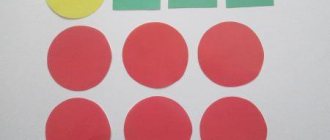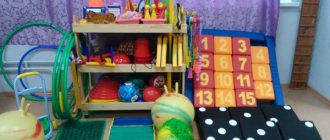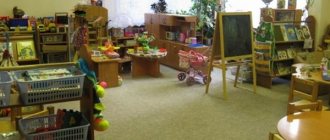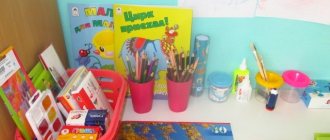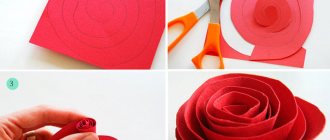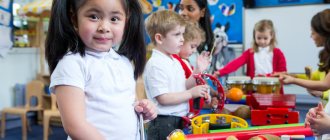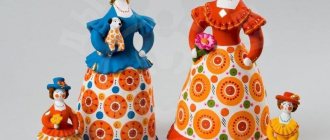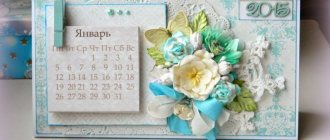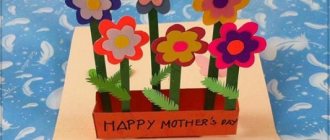Decoration of the corner “Our mood”
Organization of the corner -
“Our mood”
Teacher of senior group No. 6.
The mood corner is a means of self-knowledge and development of the child’s emotional sphere.
But there are many means of developing a person’s emotional world. Here are the simplest and most accessible ways to develop and shape a child’s emotional world.
Target:
expanding teachers’ understanding of the meaning and ways of organizing a mood corner in group rooms.
Developmental environment of preschool educational institutions
should be enriched with various elements that create in children a positive attitude and impression of the kindergarten, which will help
(tasks):
1.
Overcome the stress of admission,
2.
Successfully adapt to a preschool institution,
3
. Will contribute to the psychological and emotional health of each child’s personality,
4
. Development of the emotional and sensory sphere.
Such an environment can be called an emotionally developing environment or a mood corner.
One of the options for zoning and enriching group premises with a variety of game elements aimed at preserving the psychophysical health of preschool children, developing their emotional, sensory and communicative sphere, positive acceptance of themselves and the world around them:
1. “Welcome Corner”
Target:
promote the mental and personal growth of the child, uniting the children's team, creating a positive emotional mood, an atmosphere of group trust and acceptance; the ability to notice positive qualities in people and talk about it.
Material used:
• Stand "Hello, I'm here!"
with photos of children (when coming to the kindergarten, the child turns his photo to face those around him, i.e. declaring his presence in the group);
• Stand “My Mood”
(children use pictograms to determine their mood during the day);
• Card index of games-minutes “entering the day” (“
Compliments”, “Echo”, “Tender name”, etc.).
2. “Achievement Corner”
Target:
increase self-esteem and self-confidence of children, provide positive information for parents that helps establish mutual understanding between them;
teach children to be sensitive, respectful and friendly towards people. • “Flower of Success”/“Star of the Week”:
in the middle of the “daisy” flower there is a photo, on the petals (during the week) information is written about the child’s results for the day, which he is proud of;
• "Treasury of good deeds":
a panel with pockets for each child, where “chips” are placed for each kind and useful deed/deed (children are rewarded at the end of the week).
3. Anger Corner
Target:
provide children with the opportunity to free themselves in an acceptable form from overwhelming anger, irritation and tension.
• "Rug of Anger"
— a rubber studded mat on which children can trample;
• "Box of Anger and Irritation"
- a dark-colored box where children throw out all their “anger and resentment” (by first clenching their fists and collecting in them everything that has accumulated “bad things” or by crumpling/tearing sheets of large newspapers);
• "Pillow-beater"
bag “For shouting”, “Bridge of Friendship”, soft fabric-foam hammers, light balls (knitted pom-poms), etc.
• "Leaf of Wrath"
- a printed sheet that can be crumpled, torn, thrown, etc.
Leaf of Anger
4. “Privacy Corner”
(there should be several)
Target:
create conditions for rest, privacy for children, relaxation and independent play during the day, necessary for the expression of stressful situations experienced by children, for example, separation from parents in the morning, getting used to a new routine, etc.
• A soft sofa, comfortable armchairs, a translucent screen;
• Mobile “Transforming House”
— gives the child the opportunity to retire, if necessary, from the “noisy” environment of peers, to restore mental and emotional state/balance;
• Pillows - “thoughts”, pillows - “cryers”
”, soft toys of different sizes - by hugging such a pillow or toy, a child can share his mood with it;
• «Guardian Octopus"
with backpacks made by parents for children’s personal belongings;
• Album with family photos
pupils - at any moment a child can open it and mentally find himself close to his loved ones, feel their love, which gives a feeling of confidence and security in the world around him;
• Telephone
, by which the baby “calls” mom or dad to share something secret, etc.;
• "Sleepy" toys
help to overcome the negative states experienced by the child during the period of adaptation to a new team, contribute to the creation of positive motivation for routine moments, have a relaxing feature, and are used when putting the child to sleep.
5. “Mood Corner”
Target:
to form expressive standards in children, to contribute to the enrichment of the emotional sphere, to give the concept of the separation of positive and negative emotions, to teach them to recognize their own emotions and feelings, helping them to adequately respond to the mood of a peer or adult.
• Shelf “My mood”
- children indicate their mood during the day using “pictograms”, and the teacher gets the opportunity to determine the emotional state of each child, the reasons for its occurrence and provide timely emotional support to children in need. In each group, the panel has a specific shape: a house, a flower, etc. In the center of each panel there are pockets made of colored ribbons that indicate a certain mood (purple - “I’m angry”, blue - “I’m sad”, green - “I’m calm”, red - “I’m happy”). Each color strip is divided into 6 equal parts (pockets). The first pocket contains a schematic image of the faces of boys and girls with a certain mood. The remaining five pockets represent the days of the week. In order for children to reflect their mood, schematic images of the faces of boys and girls with corresponding emotions are made from colored cardboard.
• Various didactic games for studying emotional states
, pictogram cubes, a card index of portraits with various facial expressions and excerpts from various poems to them.
- joy, anger, horror, fear, etc.).
6. “Communication corner with nature”
Target:
teach children to relieve muscular and emotional tension, aggressiveness, using images of nature (based on observation), including them in the game, using their whole body.
• Directing games;
• Sets of families of domestic and wild animals;
• Games with sand (scoops, molds, various washable small toys are required, for example, for burying the image of the offender; digging up a “surprise” without touching it, etc.);
• Games with clay (for example, sculpting an image that causes a tense state, its further flattening, etc.);
• Games with water (competitions among paper boats driven by the wind from a straw, knocking down light toys with “sprinklers”, experimental activities “sinking or not sinking”, etc.).
7. “Theatrical and musical corner”
Target
: to promote intellectual and aesthetic development, open expression of emotions and feelings through the possibility of reincarnation into fairy-tale characters, bringing your personality into the role of the character, independently consciously use facial expressions to express your experiences, enrich and activate the emotional vocabulary.
• Various types of theaters (finger, mitten, tabletop, theater screen);
• Masks, with the ability to change the moods of literary characters/heroes, while children play out not only fairy tales, but also outdoor games;
• Musical and didactic games, instruments;
• “Music Box” - a selection of audio cassettes with a variety of melodies to create a favorable musical background in the group (not only the usual children's songs, but also folk and classical works);
8. “Corner of magical colors”
Target:
teach to express emotions, mood using artistic techniques, promote negative reactions
body emotions (fear, tension), development of imagination and personal self-expression.
• Paints, gouache, brushes, pencils, crayons, paper/wax, unfinished drawings for finishing, threads.
Advice
: when discussing drawings, one should avoid judging the technique of their execution; it is necessary to pay attention to techniques that convey the mood and experiences of the author.
9. “Bibliotherapy Corner”
Target:
teach children to understand themselves, verbally express their problems, reduce feelings of fear, shame, stimulate the development of imagination by reading specially selected literature to children, thus forming a kind of “protection” and support in real life.
10. “Surprise Corner”
Target:
relieve psycho-emotional tension, muscle tone, develop imagination, help create a friendly atmosphere, introduce an element of novelty and surprise (for example, a new musical or talking toy).
Everyone knows that preschool children are especially emotional and impressionable. They easily pick up strong, both positive and negative emotions of the people around them. In many ways, children's reaction to the situation around them depends on the teacher creating in them a sense of confidence and support, internal security and freedom. It also depends on his goodwill, acceptance of children as they are, and the ability to be a partner and comrade for them.
"School of Friendship and Kindness"
Game “Who Gave Kind Words?”
Goal: harmonization of relationships in children’s communication, teaching the ability to show kind feelings towards another person.
Age: 4–7 years.
Description Children stand in a circle. A driver is selected, sits on a chair in the center of the circle and closes his eyes. Participants in the game walk in a circle saying:
Here the game will begin now, The rain of kind words will fall. Guess who came up and gave kind words.
The child, whom the psychologist (or teacher) touches with his hand, approaches the driver and, touching him gently, gives kind words. For example, “Petya, you are caring, smart and kind.” The driver must recognize by the voice the one who gave the kind words. If the driver recognizes the player, the game continues with a new driver.
Game "Adults and Children"
This game is often used by practical psychologists (unfortunately, I cannot indicate the author). It has improved the part with the “magic” hand massage that children perform, as well as the final part of the game.
Goal: development of imagination, creation of goodwill and mutual understanding in children’s communication with each other.
Age: 5–7 years.
Description The group is divided into two subgroups: the first is “children”, the second is “adults”. “Children” sit on chairs placed in a circle. “Adults” stand behind the seated “children.” Before starting the game, they stroke and knead their hands, turning them into the gentle, kind hands of loved ones. A psychologist can show children how a “magic” hand massage is performed and accompany the actions with the words:
I will stroke my hands, Be kind little hands, To caress and gently stroke My little children.
After this, the “adults” begin to gently stroke the shoulders and arms of the “children.” After a few seconds, the “adults” change their charges. After 2–3 shifts, the “children” in their care determine: a) which “adult” is the most affectionate and gentle; b) with whose hands can the hands of an “adult” be compared: mother, father, grandfather, grandmother.
Then the “children” and “adults” change roles.
Game "School of Friendship"
Goal: children’s awareness of the value of friendly relationships in communicating with people.
Age: 5–7 years.
Description Children stand in a circle. All of them are students at the School of Friendship. An adult offers children cards with pictures of family members (mom, dad, grandmother, grandfather, brother, sister). Psychologist (or teacher):
Be careful, look: There is a family member in the picture. What can you do to become a reliable friend?
Each child takes turns telling what he can do for this or that person to become his friend.
You can also use photographs of group children and kindergarten teachers.
Comment: all games can be used in work with children by both psychologists and kindergarten teachers and parents of preschoolers.
Tatiana SHIROKOVA teacher-psychologist, MBDOU Kindergarten No. 17, Kirovo-Chepetsk, Kirov region
